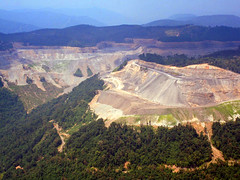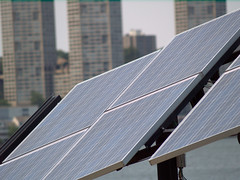 Could putting a price on nature lead to better cost-effective tracking of the impacts of global climate change? Pavan Sukhdev, a banker working with the United Nations Environment Program, says yes. Touching on the classic “Tragedy of the Commons,” Sukhdev argues that treating nature as any other market place good makes it easier to quantify and measure using cost-benefit analysis. “We cannot continue our stewardship of this planet if we keep looking at public benefits and public wealth as somehow subordinate to private wealth,” said Mr. Sukhdev. He goes on to comment that in the long run, taking action against the impacts of climate change now is much cheaper than acting later. In other words, saving what already exists today, for example biodiversity, is much more valuable than allowing it to go extinct. According to Mr. Sukhdev, his study could influence the creation of a cap-and-trade like system that might include trading water rights, forest credits, and biodiversity credits.
Could putting a price on nature lead to better cost-effective tracking of the impacts of global climate change? Pavan Sukhdev, a banker working with the United Nations Environment Program, says yes. Touching on the classic “Tragedy of the Commons,” Sukhdev argues that treating nature as any other market place good makes it easier to quantify and measure using cost-benefit analysis. “We cannot continue our stewardship of this planet if we keep looking at public benefits and public wealth as somehow subordinate to private wealth,” said Mr. Sukhdev. He goes on to comment that in the long run, taking action against the impacts of climate change now is much cheaper than acting later. In other words, saving what already exists today, for example biodiversity, is much more valuable than allowing it to go extinct. According to Mr. Sukhdev, his study could influence the creation of a cap-and-trade like system that might include trading water rights, forest credits, and biodiversity credits.
Author Archives: Tara Holmes
A Polarized Battle
 There is a battle raging in Alaska: State government vs. the polar bear. Or, to put it more bluntly: resource development vs. environmental conservation. While this battle is nothing new to Alaska, especially given the impending threats of climate change on regional wilderness, which includes the polar bear’s natural habitat. A recent comment by Governor Sean Parnell made it clear that Alaska puts politics first and polar bears last.
There is a battle raging in Alaska: State government vs. the polar bear. Or, to put it more bluntly: resource development vs. environmental conservation. While this battle is nothing new to Alaska, especially given the impending threats of climate change on regional wilderness, which includes the polar bear’s natural habitat. A recent comment by Governor Sean Parnell made it clear that Alaska puts politics first and polar bears last.
In fact, Parnell charged that the federalFish and Wildlife Service acted illegally when it listed the polar bear as threatened based on future population and climate predictions. He also vowed to keep fighting the 2008 listing of the polar bear under the Endangered Species Act. Referring to a recent recommendation by federal managers which advised designating upwards of 200,000 square miles of land and sea-ice as critical habitat for the species, “Currently, some are attempting to improperly use the Endangered Species Act to shut down resource development, and I’m not going to let this happen on my watch,” Mr. Parnell said.
All this debate comes soon after a “green light” was given to Royal Dutch Shell to drill for oil and gas in the Beaufort Sea, off of Alaska’s Arctic coast. The October 19th decision by the Minerals Management Service clears one of the final technical hurdles for the company to drill two wells on two offshore lease areas. Exploratory drilling will commence between July and October 2010, when the sea-ice melts.
As a major domestic source of oil in the United States, Alaska remains in a tug of war between political power struggles, growing oil demand, and environmentalism. Sadly, the polar bear sits in the crossfire. Reliant on arctic ice to migrate upwards of 3,000 miles a year, the polar bear’s basic survival does indeed directly depend on the climate more than many of us realize. In addition, many native villagers rely on these sensitive climate shifts for hunting and settlement. Developers however see money to be made when ice melts, allowing cargo ships to sail further and faster, and oil and gas exploration to be done with increased ease. If a truce can’t be called in a timely fashion, and if federal climate legislation continues to stall in Congress, the polar bear, and all it represents, will face extinction. Is this worth the price of oil?
Losing Support

The U.S. Chamber of Commerce is losing popularity among U.S. corporations — fast. The Washington Post recently reported that Apple is revoking its membership in protest over the Chamber’s stance on global climate change, specifically its stance against congressional legislation that would reduce CO2 emissions. Other companies to recently pull out include Pacific Gas and Electric, PNM Resources, and Exelon. Nike resigned from the Chamber’s Board, but not its membership. Given Apple’s popularity as a computer giant, the news marks hightened attention to private sector influence over climate change policy and emission regulation.
Thomas J. Donohue, the Chamber’s president, commented that while the group supports federal climate change legislation, the cap-and-trade legislation passed by the House of Representatives was flawed since it does not require other polluting countries to act. Mother Jones Magazine offered a different take and reported on the Chamber’s past record of investing millions of dollars lobbying congress to oppose the Markey-Waxman bill and threatened to sue the EPA if they continued to regulate CO2 as a pollutant. Over the next few months, it will be interesting to watch if other companies follow suit and what impact that will have on the Chamber, as well as domestic climate legislation.
Let’s Bury It?

In New Haven, West Virginia, the Mountaineer Power Plant is about to embark on the world’s first attempt to capture and bury CO2 from a coal-fired power plant (NYTimes). As early as this week, fluid CO2 will be pumped into sandstone 7,800 feet underground and then into dolomite 400 feet below that; the liquid carbon dioxide is 30 to 40 feet high and hundreds of yards in length. The plan is to inject 100,000 tons annually for two to five years with the possibility of capturing 90% if Congress finds the technology economically feasible.
Initially sparked by political pressure to limit the amount of CO2 released into the atmosphere, these plants are now faced with skeptics, scientists and environmentalists alike, who are concerned about the safety and long-term impact this new process could have. Specifically, CO2 that’s injected into the Earth can filter into the ground water increasing the levels of carbonic acid. Other skeptics are concerned about the long-term pressure that could build as a result, leading to increased earthquakes. The EPA has discounted the risk. Either way, the bigger picture amounts to our continued dependence on fossil fuels for global energy. Until Congress understands the benefit of renewable energy both as a power source and economic stimulant, we will instead be faced with daunting and frightening “solutions” to climate change—like the one taking place in New Haven, WV—which are anything but.
Earth’s “New” Ocean
A new ocean is emerging on planet Earth. This ocean was once composed mainly of solid ice, sometimes hundreds of meters thick. During this past summer however, the first known commercial shipment from Asia to Europe took place — via the Arctic (NYTimes). The German cargo vessles Beluga Foresight and Beluga Fraternity are two examples of such a new-found commercial shipping trend. The cargo carriers originally left from South Korea and are departing on their last leg from Siberia. Such a passage has been the dream of many a mariner, sea-voyager and commerical tradesman, yet the gripping reality of vast open Arctic waters is not the dream of those concerned about climate change. For about a month each summer, Arctic ice recedes to a degree that now allows cargo ships to pass through with ease, unlike in years before where large ice-breaking machinery had to be used. Scientists are concerned that this trend will lead to an economic thirst for greater speed in commerce thus fueling the world’s appetite for rapid growth and development. While growth and development aren’t necessarily evil entities unto themselves, the quantity of demand as developing nations develop and as global population soars is what puts the planet, and the long-term health of the species living on it, in serious jeopardy.
White Roofs Everywhere!

Want to know a quick, relatively easy way to reduce global climate change? Paint your rooftops white. Yes, it’s true.The way rooftops—as well as roadways are currently constructed (using dark asphalt and color scheme) creates a feedback loop of heat absorption in the atmosphere. Dark colors absorb heat, meaning less is reflected back into space. It’s a dangerous cycle. According to Professor Steven Chu, the US Energy Secretary, white roofs could be a relatively inexpensive way to cut carbon, but are also doable with immediate results. In fact, Dr. Chu commented that “lightening roofs and roads in urban environments would offset the global warming effects of all the cars in the world for 11 years” .
One could argue however that producing all the toxic paint used to complete such a massive intiative would out-weight the benefits. It’s also not necessarily a long-term solution. Furthermore, there’s the case for “living roofs” that not only absorb heat but also act as carbon sinks. Of course green roofs—they are more commonly known—take much more time, money and effort, whereas painting is a relatively easy process. Either way, acting fast yet thinking long-term is the only way to truly battle climate change. Manageable steps with gigantic impact, such as lightening roofs and roadways, is something everyone can take part in today. Perhaps, then, it’s a good place to start.
More (solar) power in Western Mass.
A proposal by the Western Massachusetts Electric Co. (WMECO) to build up to 6 megawatts of solar photovoltaic power in its service area was approved August 12th by The Massachusetts Department of Public Utilities. The utility provides power to roughly 200,000 residents in Western Mass, specifically the counties of Hampden, Hampshire, Franklin and Berkshire county. Approval was received after applying under Massachusetts’s Green Communities Act, an Act that allows utilities to own and operate solar generating facilities up to 50 megawatts. Utility revenues will be used to fund the project, and WMECO agreed to spread those charges out over a number of years. The project is set for completion and full operation by 2012.
In the New England publication Mass High Tech, DPU Chairman Paul Hibbard was quoted, “Today’s action is consistent with Gov. Patrick’s pursuit of a robust solar energy industry in Massachusetts. It moves the Commonwealth closer to the governor’s goal of 250 megawatts of solar power by 2017 while protecting ratepayers by spreading out the cost of financing WMECO’s solar ownership program.” This is great news for Western Massachusetts and serves as an example for other communities in the commonwealth.
The meat and climate debate

In a recent Washington Post article, the climate change debate was brought to a new level: what about meat? Politicians and environmental activists alike argue over cap-and-trade, mitigation, adaptation, and hybrid cars, but what about the energy used and green house gases (GHG) emitted from intensive livestock practices (factory farms) across the nation, and around the world? The Post article cited a 2006 United Nations report stating 18 percent of global GHG emissions comes from livestock. Never mind the hundreds of thousands of acres of land stripped and cleared for cattle-grazing in Brazil’s Amazon rainforest and the American West, to name just two major regions. The Amazon rainforest in particular acts as a major carbon sink on our planet, storing large volumes of CO2 from the atmosphere. Diminishing this capacity increases the precariousness of our situation.
So, is switching to a vegetarian or vegan diet all that impactful? Interestingly, a study out of the University of Chicago noted switching to a vegan diet is more environmentally friendly than owning a Prius. Still, not everyone is comfortable giving up meat in their diet. At the very least however, cutting back a little, or buying locally raised meat can cut emissions significantly, and promote local farm production and sustainability. So next time, take a second look at that hamburger you ate for lunch and think global climate change; they’re more directly related than you may think.
Coal Country

This week, the highly anticipated documentary “Coal Country” hits theaters. And, surprise, big coal is not thrilled with its release. From mountaintop removal footage to interviews with those most impacted—local residents of Appalachia—Coal Country exposes and breaks down the business of coal mining into its dirty parts. For one, an American Lung Association study shows that 24,000 Americans die each year from from coal-fired plant pollution (grist).
In addition, coal-fired power plants are major emitters of CO2, NOX, and SO2 into the atmosphere; NOX & SOX factor into acid rain. Another source of pollution may occur before the coal is even burned. In the controversial practice of mountain-top removal, a devastating process that strips off the living layers of a mountain for the sake of simpler coal extraction, heaps of tailings and overburden are often dumped as fill into valleys below or placed into poorly managed heaps whose runoff pollutes local waterways. This impacts not only those immediately adjacent to the plant, but also those further downstream. Coal remains “cheap” however, and many developing countries like China have immense deposits at their disposal, leaving the world to ponder: Will we ever break out of our addiction to coal? One can only hope. The movie opens in King Coal’s back yard on July 11th.
Clean Energy?

Last Monday, Congressman Ed Markey spoke at a Boston Chamber of Commerce luncheon in downtown Boston. The Congressman made a point to mention the Waxman-Markey bill currently being debated in Congress, and illustrated how this bill would specifically create clean energy jobs in Massachusetts. Of course, the actual impact is still undetermined considering the bill has yet to pass both houses of Congress. Nevertheless, this important piece of legislation could determine where the US stands on climate change efforts moving forward. Surprisingly however, Congressman Markey referred to nuclear energy as a strong component to this legislation, a component that may be even stronger than wind or solar power. While nuclear energy is debatably “clean” [http://www.nei.org/keyissues] from a CO2 standpoint, it is not clean from a nuclear waste standpoint. In fact, the National Repository at Yucca Mountain in Nevada is already scheduled to receive a back log of 150 million pounds of spent nuclear fuel (DOE) and it’s already at its capacity and continues to be stuck in legal limbo. To suggest that additional nuclear energy facilities are somehow a miraculous solution ignores the trading of one waste for another. Focusing on clean, renewable energy is the only way to a truly greener environment and the only way to genuine green job creation in Massachusetts.


